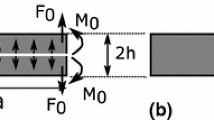Abstract
The fracture strength of PMMA is studied using columns with rectangular cross- section that contain a central hole and are subjected to axial compression. Samples with geometries such that the width is 2, 3, 4, and 5 times the diameter of the hole are investigated. Cracks are initiated by introducing sharp notches in the axial direction at the crowns of the hole in each sample. The sample is then subjected to axial compression such that the axial cracks grow in a stable manner until a critical compression is attained, after which the cracks extend rapidly in the sample but do not reach its ends. To predict the experimental results, we have first sought to use several published models, but discovered that none would produce results in accord with our data, as they seem not to address the essential features of our beam-column experiments. We have then developed a simple model that consists of a suitably modified version of an elasticity solution based on a short-crack in an infinite plate, combined with a beam-column solution for a long-crack. This model yields results in good accord with our data and also gives reasonable values for the fracture toughness of the material. A comparative discussion of several published models is presented at the end of the paper, pointing out that linear elasticity is not an appropriate tool for solving the present beam-column problem.
Similar content being viewed by others
References
Chen X, Dam MA, Ono K, Mal A, Hongbin S, Nutt SR, Sheran K, Wudl F (2002) A thermally re-mendable cross-linked polymeric material. Science 295(5560):1698–1702
Chen X, Wudl F, Mal A, Hongbin S, Nutt SR (2003) New thermally remendable highly cross-linked polymeric materials. Macromolecules 36:1802–1807
Crichton SN, Tomozawa M, Hayden JS, Suratwala TI, Campbell JH (1999) Subcritical crack growth in a phosphate laser glass. J Am Ceramic Soc 82(11): 3097–3104
Erdogan F (1962) On the stress distribution in plates with collinear cuts under arbitrary loads. Proceedings of the Fourth U.S. National Congress of Applied Mechanics
He MY, Turner MR, Evans AG (1995) Analysis of the double cleavage drilled compression specimen for interface fracture energy measurements over a range of mode mixities. Acta Metallurgica Materialia 43(9):3453–3458
Idonije K, Motuku M, Shehata I, Aglan H (1993) Evaluation of the stress intensity factor of brittle polymers based on the crack arrest concept. J Reinforced Plastics Composites 12(7):778–786
Isida M, Nemat-Nasser S (1987) On mechanics of crack growth and its effects on the overall response of brittle porous solids. Acta Metallurgica 35(12):2887–2898
Janssen C (1974) Specimen for fracture mechanics studies on glass. 10th International Congress on Glass, Kyoto, Japan, Ceramic Society of Japan
Jenne TA, Keat WD, Larson MC (2003) Limits of crack growth stability in the double cleavage drilled compression specimen. Eng Fracture Mech 70(13): 1697–1719
Marshall GP, Williams JG (1973) The correlation of fracture data for pmma. J Mater Sci 8(1):138–140
Michalske TA, Fuller ER Jr (1985) Closure and repropagation of healed cracks in silicate glass. J Am Ceramic Soc 68(11):586–590
Michalske TA, Smith WL, Chen EP (1993) Stress intensity calibration for the double cleavage drilled compression specimen. Eng Fracture Mech 45(5): 637–642
Sammis CG, Ashby MF (1986) The failure of brittle porous solids under compressive stress states. Acta Metallurgica 34(3):511–526
Turner MR, Dalgleish BJ, He MY, Evans AG (1995) A fracture resistance measurement method for bimaterial interfaces having large debond energy. Acta Metallurgica Materialia 43(9):3459–3465
Warren WE (1987) Theoretical analysis of the double cleavage drilled compression specimen. Int J Fracture 33(3):223–235
Author information
Authors and Affiliations
Corresponding author
Rights and permissions
About this article
Cite this article
Plaisted, T.A., Amirkhizi, A.V. & Nemat-Nasser, S. Compression-induced axial crack propagation in DCDC polymer samples: experiments and modeling. Int J Fract 141, 447–457 (2006). https://doi.org/10.1007/s10704-006-9006-9
Received:
Accepted:
Published:
Issue Date:
DOI: https://doi.org/10.1007/s10704-006-9006-9




